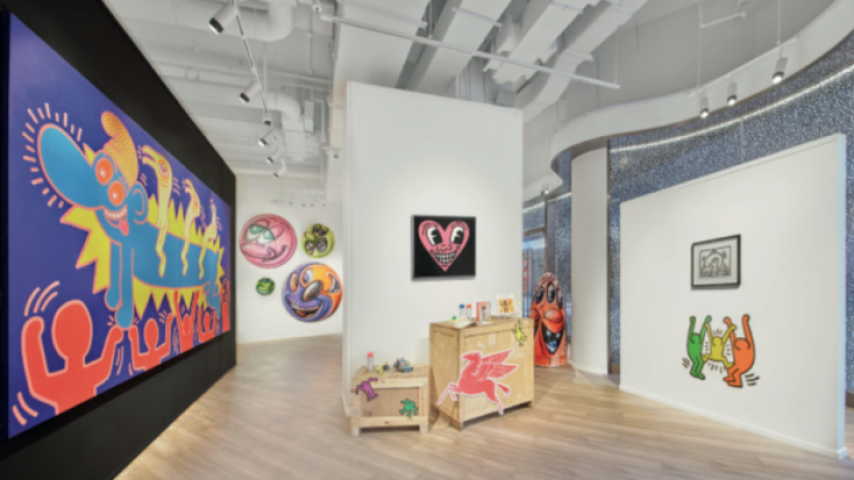
Committed to always offering brand new experiences to the public, Opera Gallery presented its latest immersive exhibition “Basquiat, Haring, Scharf” at its Hong Kong venue from April 1 to May 14, 2022. The show highlighted the works of the “three musketeers” of New York’s East Village in the 1980s.
Bringing back a revolutionary moment in the history of art, the exhibition took the visitors to the world of three of the leading art practitioners. On the gallery’s windows, massive Haring drawings were printed to resemble the shop Haring opened back in 1986. Behind these prints, one could notice Scharf’s Neo-pop characters hanged on the gallery’s wall reflecting the joyousness of this alternate world. While the ground floor was dedicated to Haring and Scharf, the second floor was filled with Basquiat’s paintings and drawings, inspiring the visitor with his own cultural heritage and New York’s hip-hop culture. On the same floor, a gallery-version of Haring’s pop-up shop with his fluorescent characters was installed and welcomed Haring and Scharf’s works to be part of the installation. This curated exhibition immersed the visitors in a unique universe of such a pivotal time in the history of art.
Their story began in the 1980s in New York, the city that never sleeps. Famously known for its hustle and bustle, the youth culture thrived in the big city; making it the place that matters for artists. Jean- Michel Basquiat (1960-1988) and Keith Haring (1958- 1990) blazed a trail in the 1980s art world and Kenny Scharf (1958-) continues to do so. Their names are synonymous with the downtown New York art scene and its underground culture of graffiti and hip-hop. And yet their artworks—joyful, angry, defiant and, ultimately, optimistic expressions of change are as relevant to our current times as ever. Despite their rivalry, these artists are much more complementary than one might believe at first sight. Through their aesthetic claims, it is in fact societal ideals that they sought to represent in their own and shared struggles. Through their friendship, they fought against the elitism of art, against racism and the stigma of disease, by bringing a form of activism in their works.

New York, and particularly the counter- cultural East village, proved the ideal stage for artistic invention regarding this matter. As Haring expressed, “Obviously, the only place to go was New York. It was the only place where I would find the intensity I needed and wanted. I wanted intensity for my art and I wanted intensity for my life.”
Immersed in art, “the three of us definitely rejected the elitist art of the time, and that’s where we really had a bond,” recounts Scharf.
In part, their street art reflected this anti-elitism ideology. Compositions filled New York walls as seen in Basquiat’s early drawings, Untitled, 1981 (included in this exhibition) or even in Scharf’s spray- painted murals on city walls.
On display at Opera Gallery, Untitled, 1994 recalls Scharf ’s street murals with its spray paint application and representation of crazy Neo- pop characters.
Heavily influenced by Graffiti Art, Haring took over New York’s subways. From 1980 to 1985, he executed thousands of drawings using white chalk on the soft black paper that covered vacant advertising billboards. Created with white marker on black paper, Honda, 1987 (included in this exhibition) captures the rapid spirit of this earlier art exploration.
While street art united these artists, their work was also associated with the New York downtown club scene at venues like The Mudd Club and Club 57, where hip-hop, punk rock, art and performance merged. The “three musketeers” were featured in different upbeat shows and exhibitions that shaped the development of American art.
For Haring, performance was a way of making art accessible to all. As early as 1978, he created immersive art “environments,” where walls, ceiling and floor were part of the work. Haring wrote in his journal that “these environments are not only for people who understand art. They can be experienced by anybody, anywhere...Art is for everyone.” As part of this exhibition, Opera Gallery’s windows and first floor are decorated in homage to Haring’s egalitarian art environments.
Jean-Michel Basquiat and Keith Haring may have passed away, but today Scharf ’s œuvres continue to dialog with their art.
The exhibition offered visitors a visual immersive experience to present the three artists and their works.

